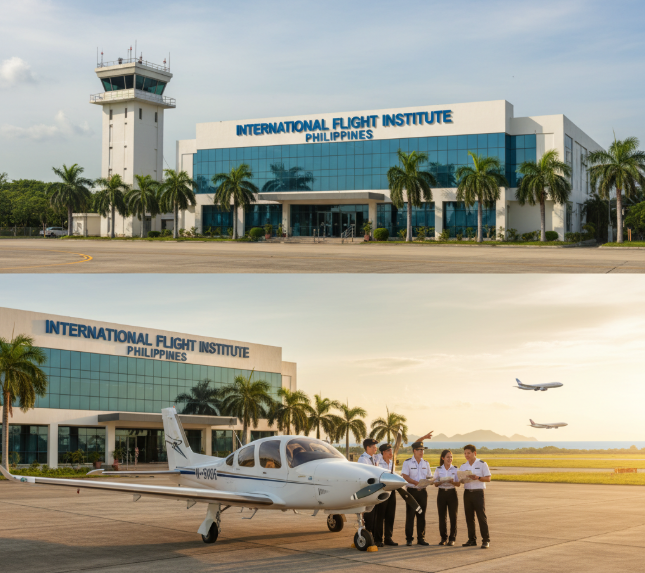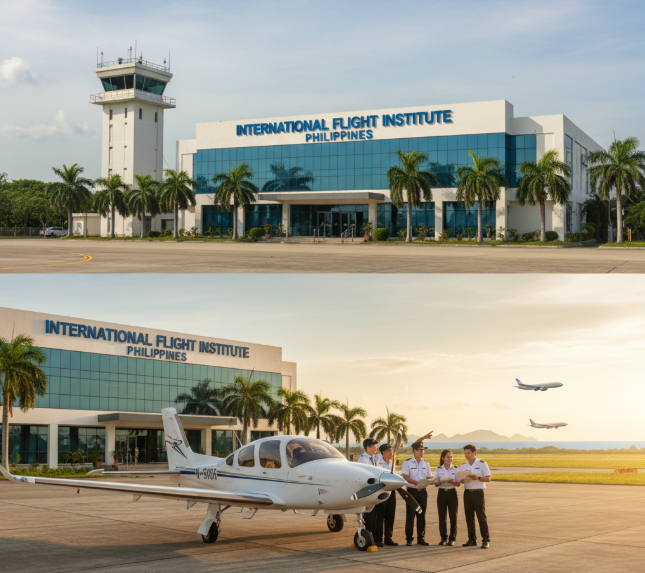
Aviation plays a crucial role in the development of a country’s infrastructure, economy, and international standing. In the Philippines, the aviation sector is no different, and the growing demand for trained pilots has led to the rise of various International Flight Institutes in the region. This blog post will serve as an all-inclusive guide to international flight training in the Philippines, covering essential topics ranging from the history and development of aviation to the various training programs available, the eligibility requirements, career opportunities, and much more.
Introduction to International Flight Institute in Philippines
An International Flight Institute is an institution that provides professional training to individuals aspiring to become pilots, flight instructors, or aviation specialists. These institutes offer structured programs designed to provide both theoretical and practical knowledge in aviation. In the Philippines, many international flight schools offer programs that meet global standards, making them an attractive destination for aspiring pilots from around the world.
What is a Flight Institute?
A flight institute, often called a flight academy or aviation school, is an educational institution that provides pilot training and aviation-related courses. They teach students to fly various aircraft and prepare them for licensing exams required by national aviation authorities. The training includes classroom instruction on topics such as aviation theory, flight navigation, meteorology, and air traffic control, combined with hands-on training in flight simulators and real aircraft.
The Philippines is home to several renowned international flight institutes that provide training for future pilots, flight attendants, and aviation specialists. The programs typically include:
- Private Pilot License (PPL)
- Commercial Pilot License (CPL)
- Airline Transport Pilot License (ATPL)
- Flight Instructor License (CFL)
- Airline Pilot Programs
These programs are designed to meet international standards, which are crucial for aspiring pilots who wish to work in airlines or international aviation agencies.
Importance of Aviation in Philippines
Aviation plays an essential role in the Philippines’ economy and connectivity. The Philippines is an archipelago of over 7,000 islands, which makes air travel crucial for both domestic and international connections. The country has seen exponential growth in the aviation sector, driven by increased demand for air travel, both for tourism and business.
Key Factors for the Growth of Aviation in the Philippines
- Geographical Significance: The Philippines’ location in Southeast Asia makes it a strategic hub for both regional and international air travel.
- Tourism: The country’s booming tourism sector requires a vast network of flights to various tourist destinations.
- Economic Development: As the economy grows, so does the demand for cargo transportation and commercial aviation services.
- Job Creation: The aviation industry generates a wealth of job opportunities for pilots, cabin crew, air traffic controllers, engineers, and other aviation professionals.
Due to these factors, the aviation industry in the Philippines is poised for continued expansion, creating significant career opportunities for aspiring pilots and aviation professionals.
History and Development of Aviation in Philippines
Early Aviation History
The history of aviation in the Philippines can be traced back to the early 1900s when the first successful flight in the country was made by the Wright brothers’ aircraft. Since then, the country has seen steady development in aviation technology, infrastructure, and training. The first Philippine airlines, such as Philippine Airlines (PAL), were founded in the 1940s, marking a pivotal point in the development of civil aviation.
Milestones in Philippine Aviation
- 1941: Philippine Airlines (PAL) began operations, becoming the first airline in the country and one of the oldest in Asia.
- 1960s: The establishment of major international and domestic air routes, increasing global connectivity.
- 1990s: The advent of low-cost carriers, further boosting air travel accessibility.
- 2000s-Present: Expansion of airports and the introduction of more advanced aviation technologies.
Current Role of International Flight Institutes in Philippines
International flight institutes in the Philippines play a key role in shaping the future of the country’s aviation sector. These institutions train individuals to become skilled pilots, flight instructors, and aviation professionals, ensuring the industry is supplied with competent and qualified personnel.
The Role of Flight Institutes Today
- Pilot Training: Flight institutes provide world-class pilot training programs that adhere to international standards set by aviation regulatory bodies like the Civil Aviation Authority of the Philippines (CAAP) and International Civil Aviation Organization (ICAO).
- Flight Simulator Training: With the advancement of technology, flight simulators are a crucial part of training programs, allowing students to practice various flight scenarios without leaving the ground.
- Employment Opportunities: Graduates from these institutes have the opportunity to work with leading airlines, aviation agencies, and even private companies involved in air travel and cargo services.
Their Role in Civil Aviation and Defense
In addition to training pilots for civilian airlines, many institutes also play a role in the defense sector by training military pilots or offering specialized aviation programs for defense services. They also contribute to space exploration programs by training professionals for roles in agencies like NASA, ISRO, or ESA.
Eligibility, Training, and Skills Required
Basic Qualifications
To enroll in an international flight institute in the Philippines, aspiring pilots must meet certain eligibility criteria:
- Age: Typically, students must be at least 17 years old to begin training for a Private Pilot License (PPL), and at least 21 years old for a Commercial Pilot License (CPL).
- Education: A high school diploma is required, although a college degree may be preferred for advanced programs like the ATPL.
- Health: A valid medical certificate is essential, as pilots must meet certain physical and mental health standards.
Technical and Soft Skills
- Technical Skills: Pilots need to master navigation, aerodynamics, meteorology, and flight mechanics. Flight training will include hands-on practice using aircraft and flight simulators.
- Soft Skills: Communication, leadership, decision-making, and problem-solving skills are crucial, as pilots must handle high-pressure situations while ensuring passenger safety.
Institutes, Academies, and Training Centers in Philippines
The Philippines is home to several renowned flight training institutions, both local and international. Some of the most notable ones include:
- Philippine State College of Aeronautics – Known for offering comprehensive aviation programs, including pilot training, air traffic control, and aviation management.
- Asian Institute of Aviation – A leading flight school in the Philippines offering a wide range of aviation courses, from PPL to CPL.
- Aviation Academy of the Philippines – One of the best aviation schools in the country, providing training for commercial pilots and aircraft maintenance engineers.
- Royal Air International – Offers both local and international flight training programs, catering to aspiring pilots seeking global career opportunities.
- Transpacific Aviation Academy – A popular school offering high-quality flight training and ground school courses.
These institutions provide comprehensive programs designed to help students succeed in both national and international aviation careers.
Technology and Innovation in Aviation Training
The global aviation industry is evolving, and technology is playing a key role in pilot training. In the Philippines, flight institutes are embracing innovation to offer cutting-edge training:
- Flight Simulators: Modern flight simulators are used extensively to provide real-time training experiences in a safe and controlled environment. These simulators replicate various flight conditions, allowing pilots to practice emergency scenarios and learn navigation techniques.
- AI in Aviation: Artificial Intelligence (AI) is being used to improve cockpit training, enhance flight path planning, and aid in decision-making processes.
- Digital Cockpits: Many flight schools in the Philippines now use digital cockpits in their training aircraft, which replicate the modern technology found in commercial aircraft.
Challenges Faced in Pilot Training in Philippines
Despite the growth and success of the aviation industry in the Philippines, there are still several challenges that flight schools face:
- Infrastructure Gaps: While training facilities and flight simulators have improved, some flight schools still struggle with outdated infrastructure.
- Costs: The cost of pilot training can be prohibitive for many students, with training for a commercial pilot license (CPL) running into several million pesos.
- Regulatory Hurdles: Navigating the regulatory processes with agencies like CAAP can be challenging, especially for international students.
Brain Drain
There is also the issue of brain drain, where well-trained pilots often leave the Philippines to work abroad, especially in countries like the United States, the Middle East, and Singapore, where they can earn higher salaries.
Future of International Flight Institutes in Philippines
The future of aviation in the Philippines looks promising, with several exciting developments on the horizon:
- Space Tourism: The Philippines is looking to be a part of the burgeoning space tourism industry, with potential projects in collaboration with global space agencies.
- Private Aviation: With growing interest in private air travel, there will be an increasing demand for trained pilots in the private aviation sector.
- AI and Automation: The rise of AI in the aviation industry will change the way pilots are trained, with a greater focus on automated flight systems and AI-assisted cockpit training.
National Projects
Aviation institutes will also be a vital part of national projects, such as the Philippine Space Agency’s initiatives, and potentially contributing to global projects like NASA’s Artemis Program or India’s Gaganyaan Mission.
Career Path & Opportunities
A career in aviation is highly rewarding and offers numerous growth opportunities. Below is a step-by-step breakdown of the career path for aspiring pilots in the Philippines:
- Education: Begin with a high school diploma or equivalent, followed by a college degree (optional but recommended).
- Pilot Training: Enroll in a flight academy to obtain your PPL, CPL, or ATPL.
- Experience: Gain flight hours by working with regional airlines, cargo companies, or as a flight instructor.
- Advanced Training: As you accumulate experience, you can pursue more advanced training for specialized roles like flight instructor or airline captain.
Local Salary Expectations
While salaries for pilots in the Philippines can vary, the average salary for a commercial pilot ranges between PHP 50,000 to PHP 150,000 per month, with airline captains earning significantly higher salaries.
FAQs
1. How much does pilot training cost in the Philippines?
Pilot training in the Philippines can cost anywhere from PHP 500,000 to PHP 3,000,000 depending on the type of license you pursue.
2. Which is the best aviation institute in the Philippines?
Some of the best institutes include the Philippine State College of Aeronautics, Asian Institute of Aviation, and Transpacific Aviation Academy.
3. What qualifications are needed for pilot training in the Philippines?
You need at least a high school diploma, a clean bill of health, and be over 17 years old to start pilot training.
4. Is international flight training available in the Philippines?
Yes, the Philippines offers international flight training programs that meet global aviation standards.
Conclusion
The aviation industry in the Philippines continues to grow, offering countless opportunities for those interested in pursuing a career in aviation. With a wealth of internationally recognized flight schools, state-of-the-art training facilities, and a thriving aviation market, the Philippines stands as a beacon for aspiring pilots looking to launch their careers.
If you’re passionate about aviation and ready to embark on a thrilling career, the International Flight Institutes in the Philippines provide the perfect starting point to make your dreams take flight.
